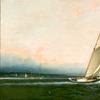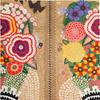Center for Art and Thought Launches New Website and Commissioned Art
- DAVIS, California
- /
- August 01, 2013
Deception Pass: New Commissioned Art by Kat Larson Online August 1
The Seattle-based artist's video piece is one of 40 works by artists and scholars in the curated exhibition, "Sea, Land Air: Migration and Labor," on CA+T's new website.
The Center for Art and Thought (CA+T), a web-based arts and education nonprofit organization, announces the premier of a new commissioned work: Deception Pass by cross-disciplinary artist Kat Larson. The video work is part of CA+T's first curated exhibition "Sea, Land, Air: Migration and Labor," which begins August 1 and will run for the next three months on CA+T's new official website (www.centerforartandthought.org).
A meditative and transfixing video piece, Deception Pass is inspired by the beautiful waterway area with the same name north of Seattle. Larson, who has deep ties to the city on both her mother and father's sides, uses the whole of her body to be one with the land on which her Filipino and Scandinavian ancestors fostered their hopes and dreams. This juxtaposition results in unlikely connections, the transformation of spaces, and an archive of truths and deceptions passed down orally over the generations.
CA+T commissioned Deception Pass in January 2013, asking Larson to create a work inspired by the themes of CA+T's inaugural curated exhibition "Sea, Land, Air: Migration and Labor." The online exhibition features work from over 40 artists and scholars from around the world centered on the theme of Filipino global migrancy and labor.
Over the last half century, the Philippines has become one of the leading labor-exporting countries in the world. With its multiple histories of colonialism (Spain, the United States, Japan), dependency on transnational political and economic institutions is not new to Filipinos. However, with increased globalization, the Philippines has transformed into what sociologist Robyn Magalit Rodriguez calls a "labor brokerage state"—a country "which actively prepares, mobilizes, and regulates its citizens for migrant work abroad." Whether in Hong Kong, Italy, Qatar, or the United States, many Filipinos eke out meager livelihoods abroad while sending remittances to support their kababayans [families and close friends] in the Philippines, a system that has come to serve a vital role in the Philippine economy. “Sea, Land, Air” brings together a rich, diverse, and thought-provoking selection of artists and scholars from across the globe to help visualize, imagine, and engage in critical thought and conversation about these dynamics of Filipino migration and labor.
Several contributions to "Sea, Land, Air" ground circuits of Filipino migration and labor in the Philippines' multiple colonial and imperial histories. Lordy Rodriguez’s stunning reconfiguration of maps in North Pole (2009) and South Pole (2009), for example, re-imagines territorial colonial conquest and maps out trade routes that engage cartography's fictions and imperial foundations. This work is accompanied by a number of visual art contributions that illuminate the iconographic details associated with Filipino migrant labor. Mik Gaspay's photorealistic painting Pacific Fleet (2008) references how navy uniforms became a source of geographic and economic mobility for thousands of Filipino sailors who enlisted as stewards in the U.S. Navy during the American colonial period and thereafter. Historian Catherine Ceniza Choy writes that, like military uniforms, the white nurse's cap on Filipinas "symbolically and literally became a passport to a more prosperous life" as well as a source of the physical and psychic struggle made visible in Jenifer K. Wofford's Nurse (2006-2007), Point of Departure (2007), and MacArthur Nurses (2009) series.
The exhibition also includes work that brings to the fore the affective dimensions of migration. Perhaps It Was Possibly Because (2009), a selection of photographs by Wawi Navarroza, resembles snapshots taken by someone in transit, perhaps a tourist or a migrant laborer, and embodies pathos that projects a fitting yet unsettling sensibility onto the concept and reality of displacement. Scholarly contributions, such as Clement Camposano's "Enacting Embeddedness through the Transnational Traffic in Goods" and Claudia Liebelt's "'We Are the Jews of Today,'" explore Filipino migrants' attempts to create and sustain physical as well as sensate conceptions of "home" in Hong Kong and Israel. Conceptual artist Miguel Libarnes' video installation Oath/Panatang (2012) complements these works, revealing the schizophrenic nature of national allegiances that many Filipinos settled abroad continue to endure.
"Sea, Land, Air" also features the inaugural installation of CA+T's Dialogues series, which brings together a selection of artists, writers, and scholars for a sustained, thematically-driven conversation. In this installation, Migrant Musicians: Filipino Entertainers and the Work of Music Making, Theodore S. Gonzalves, R. Zamora Linmark, and Karen Tongson join in a conversation moderated by Sarita Echavez See. Informed by their artistic and scholarly work and by their own histories and experiences, they reflect, in an exchange of e-mails and Facebook messages, on the ways in which Filipino musicians have circulated as part of a global entertainment industry and on how the process of transforming "living song into living labor" can disguise and deny the work that undergirds the making and feeling of music.
###
Contact:
Matthew AndrewsCenter for Art and Thought
(323) 452-3550
pr@centerforartandthought.org
info@centerforartandthought.org
(323) 452-3550
About Center for Art and Thought
Starting from the perspectives of Filipinos around the world, the Center for Art and Thought (CA+T) harnesses the potential of digital and new media technologies in order to foster dialogues between artists, scholars, and the broader public. A web-based nonprofit organization, we believe that the convergence between art and critical thought is a crucial way to generate new modes of knowledge production and creative and critical lenses for understanding and transforming global conditions.







_-Closing-the-Distance_100x100_c.jpg)








